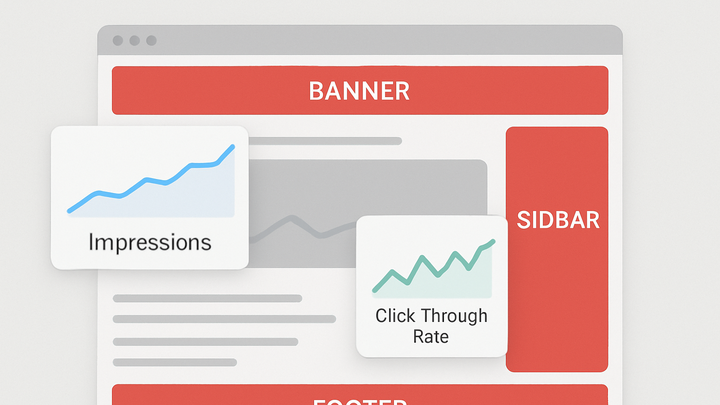Published on 2025-06-26T05:23:48Z
What are Ad Units? Examples of Ad Units in Analytics
Ad Units are discrete containers on digital properties (websites and mobile apps) designated to display advertisements. They are defined by specific dimensions (for example, 300×250 for a medium rectangle) and strategic placements (such as header, sidebar, or interstitial). In analytics, tracking ad unit performance provides insights into key metrics including impressions, clicks, click-through rate (CTR), and revenue per thousand impressions (RPM). Platforms like Google Analytics 4 (GA4) and cookie-free analytics solutions such as PlainSignal enable marketers and publishers to collect detailed data on each ad unit’s effectiveness. By analyzing this data, teams can optimize ad placements, formats, and content to improve both user experience and monetization outcomes.
Ad units
Containers on digital properties for displaying and tracking ads, measured by impressions, clicks, and revenue metrics.
Definition and Components
This section covers the key components of ad units: their dimensions/formats and placement strategies on digital properties.
-
Dimensions and formats
Ad units are sized according to standard dimensions and formats defined by ad networks (e.g., IAB). Common formats include banners, leaderboards, and skyscrapers.
-
Banner (300×250)
A medium rectangle ad unit commonly used within content areas.
-
Leaderboard (728×90)
A wide horizontal ad unit typically placed at the top of pages.
-
Skyscraper (120×600)
A tall vertical ad positioned in side columns.
-
-
Placement strategies
Placement refers to where ad units appear on a page or in an app, affecting visibility and user engagement.
-
Above the fold
Positions visible without scrolling, yielding higher viewability.
-
Below the fold
Slots lower on the page; often less viewable but can reduce intrusion.
-
Interstitial & in-stream
Full-screen or in-line video ads that appear at natural content breaks.
-
Why Ad Units Matter
Ad unit metrics are vital for assessing ad performance, revenue impact, and user engagement in digital analytics.
-
Performance measurement
Tracking impressions, clicks, and CTR per ad unit yields granular insights into effectiveness.
-
Revenue optimization
Analyzing RPM and eCPM by ad unit helps optimize placement and bidding strategies.
-
User experience
Balancing ad quantity and format is crucial to maintain site speed and user satisfaction.
Implementing Ad Unit Tracking
A practical guide to implementing ad unit tracking in popular analytics platforms, including GA4 and PlainSignal. We show code snippets and configuration steps for each.
-
GA4 tracking setup
Use Google Analytics 4 to track ad unit impressions by sending a custom
ad_impressionevent with anad_unitparameter. Example:<script async src='https://www.googletagmanager.com/gtag/js?id=GA_MEASUREMENT_ID'></script> <script> window.dataLayer = window.dataLayer || []; function gtag(){dataLayer.push(arguments);} gtag('js', new Date()); gtag('config', 'GA_MEASUREMENT_ID'); gtag('event', 'ad_impression', { ad_unit: 'sidebar_300x250' }); </script>-
Custom event registration
Define
ad_impressionin GA4 as a custom event and registerad_unitas a parameter in your property settings. -
Data analysis
Use GA4 reports or BigQuery export to analyze ad unit performance across dimensions like device and geography.
-
-
PlainSignal tracking setup
PlainSignal is a cookie-free analytics solution that can capture custom events. First, install the tracking script, then use the PlainSignal API to log ad impressions. Example installation:
<link rel='preconnect' href='//eu.plainsignal.com/' crossorigin /> <script defer data-do='yourwebsitedomain.com' data-id='0GQV1xmtzQQ' data-api='//eu.plainsignal.com' src='//cdn.plainsignal.com/plainsignal-min.js'></script>-
Install PlainSignal script
Add the above code snippet to your
<head>section to load the PlainSignal library. -
Log ad impressions
Invoke the PlainSignal event API to send an ad impression for each ad unit:
plainSignal.track('ad_impression', { ad_unit: 'sidebar_300x250' });
-
Best Practices
Tips to optimize ad units for performance, revenue, and user experience.
-
Use responsive ad units
Implement responsive ad tags that adapt to different screen sizes and orientations.
-
Limit ad quantity
Avoid overcrowding pages with too many ads to preserve loading speed and UX.
-
Test and iterate
Continuously A/B test ad formats, positions, and frequency to find optimal configurations.
